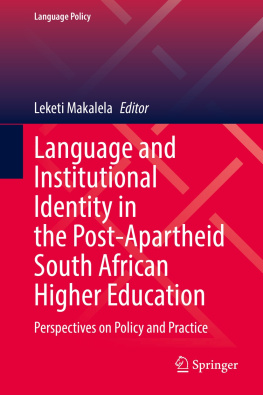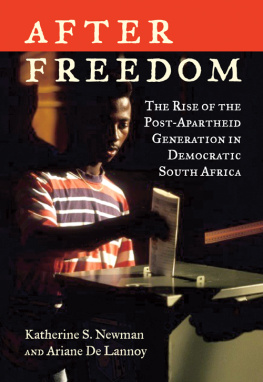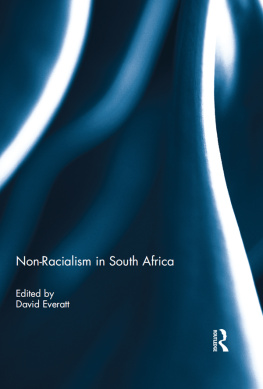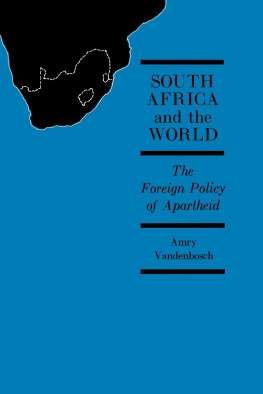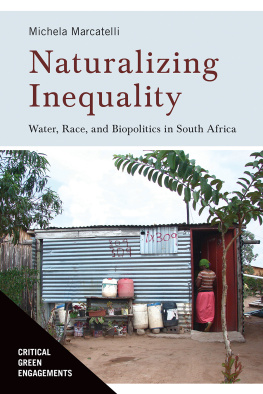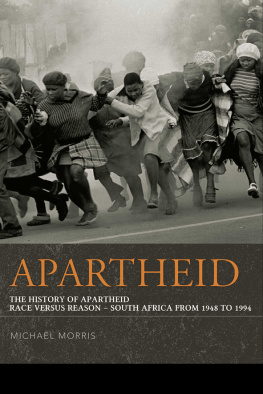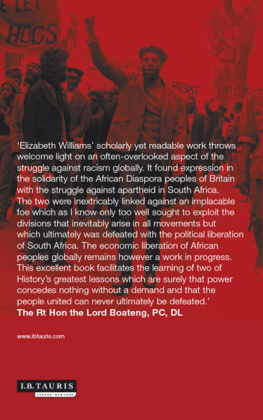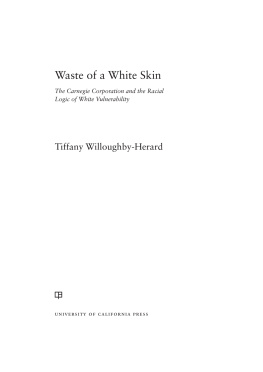THE COLOUR OF OUR FUTURE
DOES RACE MATTER IN POST-APARTHEID SOUTH AFRICA?
Edited by
Xolela Mangcu
Published in South Africa by:
Wits University Press
1 Jan Smuts Avenue
Johannesburg, 2001
www.witspress.co.za
Compilation Xolela Mangcu 2015
Chapters Individual contributors 2015
Foreword David Scott 2015
Published edition Wits University Press 2015
First published 2015
978-1-86814-569-0 (print)
978-1-86814- 623-9 (PDF)
978-1-86814-910-0 (EPUB: North America, South America, China)
978-1-86814-911-7 (EPUB: Rest of the World)
All rights reserved. No part of this publication may be reproduced, stored in a retrieval system, or transmitted in any form or by any means, electronic, mechanical, photocopying, recording or otherwise, without the written permission of the publisher, except in accordance with the provisions of the Copyright Act, Act 98 of 1978.
Edited by Inga Norenius
Proofread by Lisa Compton
Index by Clifford Perusset
Cover design by Michelle Staples
Typeset by Newgen
Printed by Paarl Media, South Africa
To the memory of Martin Bernal, who once said, memorably, I am the enemy of purity.
CONTENTS
Xolela Mangcu
Nina G Jablonski
Lawrence Blum
Steven Friedman
Mark Swilling
Vusi Gumede
Joel Netshitenzhe
Suren Pillay
Crain Soudien
Hlonipha Mokoena
FIGURES AND TABLES
ACRONYMS AND ABBREVIATIONS
| ANC | African National Congress |
| BNG | Breaking New Ground |
| CCRRI | Centre for Critical Research on Race and Identity |
| Cosatu | Congress of South African Trade Unions |
| HDI | Human Development Index |
| HOA | Home Owners Association |
| HPI | Human Poverty Index |
| IDP | Integrated Development Plan |
| IMF | International Monetary Fund |
| JSE | Johannesburg Stock Exchange |
| Ma | million years ago |
| MEC | Mineral Energy Complex |
| NDP | National Development Plan |
| NIMBY | not in my backyard |
| PAC | Pan Africanist Congress |
| PERC | Programme for the Enhancement of Research Capacity |
| SACP | South African Communist Party |
| SARChI | South African Research Chairs Initiative |
| UCT | University of Cape Town |
| Unisa | University of South Africa |
| UVR | ultraviolet radiation |
| UWC | University of the Western Cape |
| Wits | University of the Witwatersrand |
FOREWORD
PARADOXICAL TIME
In his novel about the English peasant revolt of 1381, A Dream of John Ball (1888), the great nineteenth-century artist and socialist William Morris makes this observation about the past in the present: I pondered all these things, and how men fight and lose the battle, and the thing that they fought for comes about in spite of their defeat, and when it comes turns out not to be what they meant, and other men have to fight for what they meant under another name. Disclosed in this condensed reflection is an important lesson about how we think or should think in a properly historical way. Evidently, the relationship between the past and the present, between winning and losing (political struggles, for example), between what we aim for and what we get, is not what we would expect from the perspective of a seamless, linear notion of causes and results. Discontinuities are embodied in the appearance of continuities, and continuities are often characterised by surprising discontinuities. What Morris suggests is that history, how the past relates to the present, should be thought of as paradoxical. Notably too, his insight has about it a tragic aura, in that it solicits from us a suspension of our progressivist expectations about the secure connection between the intentions of reasoned agency and the outcomes of plurally constituted historical action. And therefore what is entailed in thinking historically is an ongoing attunement to the non-synchronicity of pasts in the present. Ive found myself returning again and again to this singular recognition.
Indeed, although nowhere explicit, Morriss insight was constantly in the background of the thinking that went into my writing of Conscripts of Modernity. Part of the point of that book was to offer a historiographical intervention into the writing of present histories of the colonial past. Put it this way: a long struggle was waged against colonial domination that in some paradoxical fashion was both won and lost inasmuch as something new and important emerged into the world but at the price of preserving something old. CLR Jamess legendary book The Black Jacobins was of course my ostensible object (structured as it was around the themes of anti-colonial revolution and black political self-determination), and the contrast between romance and tragedy as modes of historical emplotment the specific theoretical axis of my preoccupations. But the larger objective into which these were folded was that of rethinking and rewriting the continuities and discontinuities between the colonial past and the postcolonial present, as a way of contributing to unsettling the complacencies and sense of stalled political possibilities that afflict our time. It seemed to me that central to the narrative poetics of liberationist (including anti-colonial) self-consciousness was a way of linking a past of intolerable subjection through a present of possible action to a promised future of total overcoming. This of course was understandable, even desirable, given the history of our victimisation and our natural search for the simple vindication of our humanity. But what if the futures imagined by the figuration of that past had now been effectively foreclosed by both political and conceptual transformations? What were we now to do with the concepts that had so naturally organised our political dreams of futures without the subjugations (racial and otherwise) derived from our colonial experience? This is why the idea of a problem-space of questions and answers (which I formulated by way of the work of RG Collingwood and Quentin Skinner) seemed to me such a productive way of thinking the distinctive historicities of what Stuart Hall might have called successive conjunctures. What distinguishes one problem-space from another, as I see it, is less the prevailing answers offered for various conundrums than the assumptions that shape their underlying questions. Answers are always linked conceptually to more or less implicit questions. And therefore, to understand the present as a conjuncture, part of what is necessary is to try to discern, to excavate, the distinctive questions that constitute and orient it.
The essays in The Colour of Our Future seek, separately and together, to take the measure of the racial present in contemporary South Africa not an easy undertaking in any circumstance. It is by now uncontroversial to say that the story of the making of the new/democratic/post-apartheid South Africa is often told as a narrative of the heroic struggle to overcome the entrenched and vicious racial past and to found a constitutional republic based on the refusal of racial identifications and exclusions. Central to this motivated narrative (one that gradually became the hegemonic if never uncontested one over the course of hard and sometimes bitter rivalries) was the demand to reject racial and ethnic self-identification as being in implicit collusion with the classificatory and administrative practices of the apartheid state. Race and ethnic consciousness were therefore frowned upon as morally suspect and politically retrograde. A principled non-racialism had become the oppositional norm, perhaps even the politically correct orthodoxy. But in the conjuncture of post-apartheid South Africa, as the novelty of procedural democracy recedes and the pleasures and conceits of white privilege (not to mention the economic structures that sustain it) recognisably prevail in barely diminished form, it is no longer as clear as it once seemingly was that the great doctrine of non-racialism is self-evidently the best way to engage and combat the scourge of individual and institutional racism.




